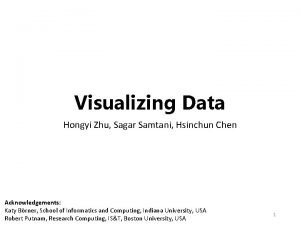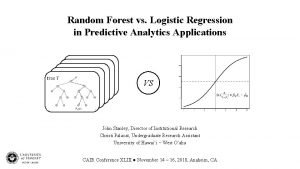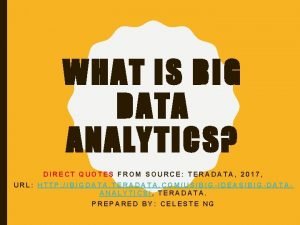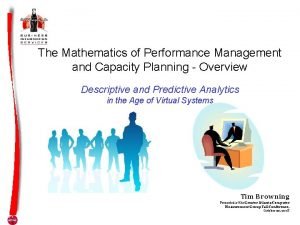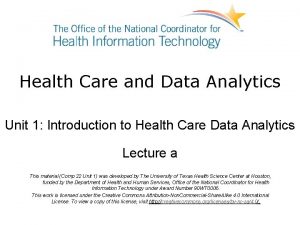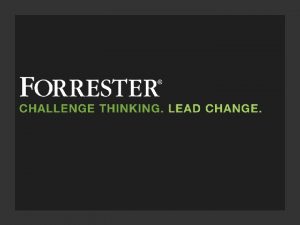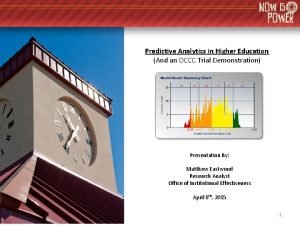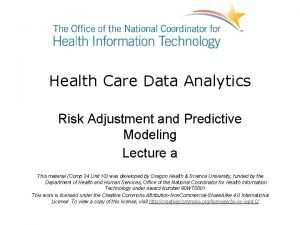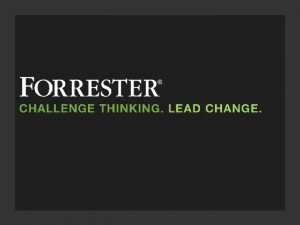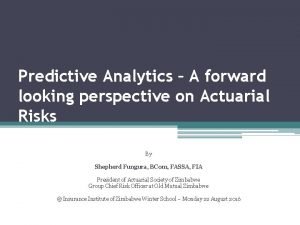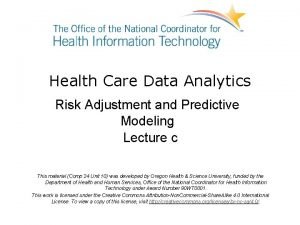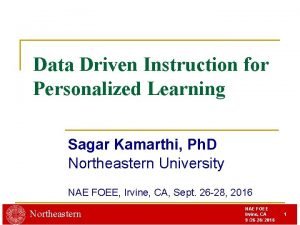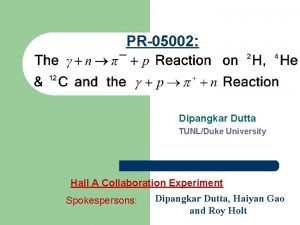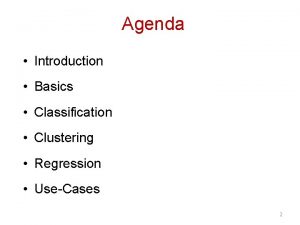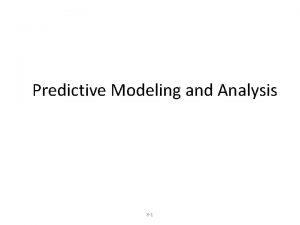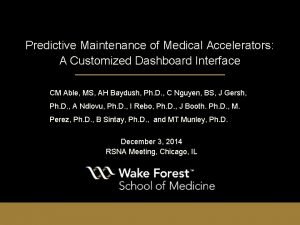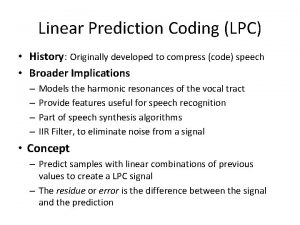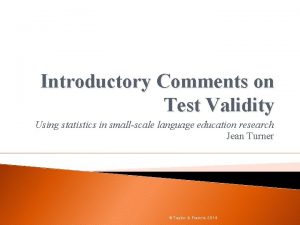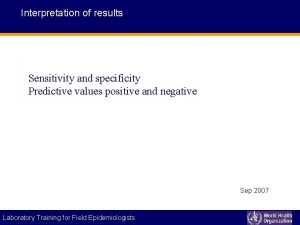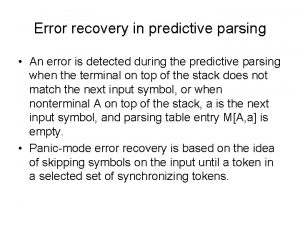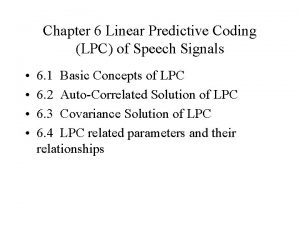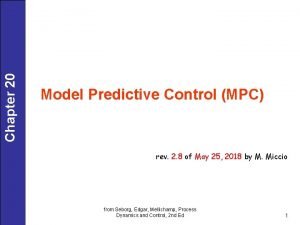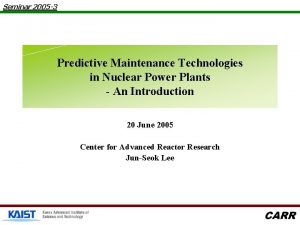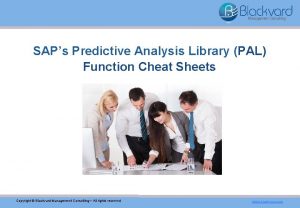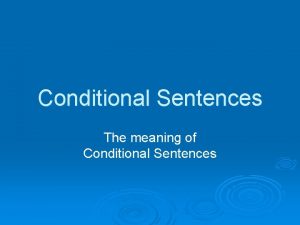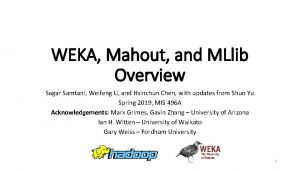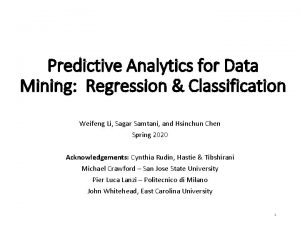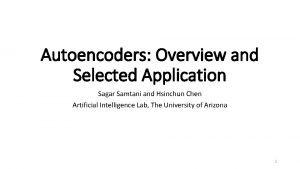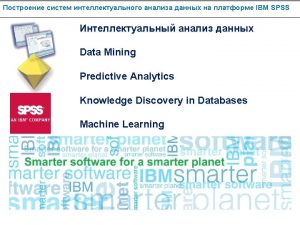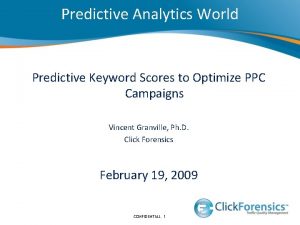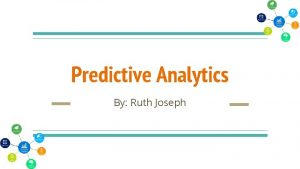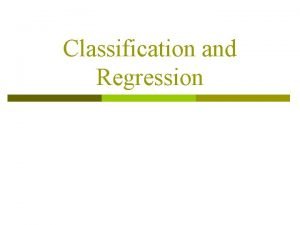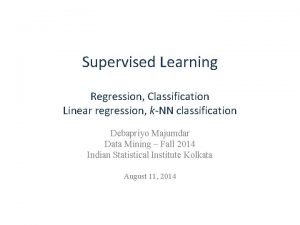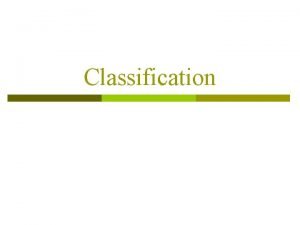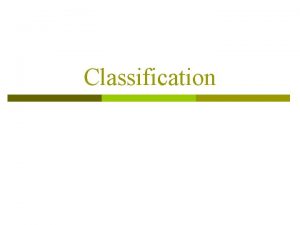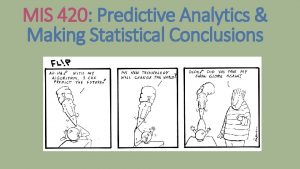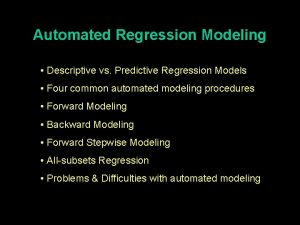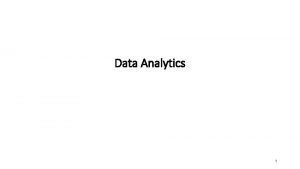Predictive Analytics Regression Classification Weifeng Li Sagar Samtani




























































- Slides: 60

Predictive Analytics: Regression & Classification Weifeng Li, Sagar Samtani and Hsinchun Chen Spring 2016 Acknowledgements: Cynthia Rudin, Hastie & Tibshirani Michael Crawford – San Jose State University Pier Luca Lanzi – Politecnico di Milano 1

Outline • Introduction and Motivation • Terminology • Regression • Linear regression, hypothesis testing • Multiple linear regression • Classification • • • Decision Tree Random Forest Naïve Bayes K Nearest Neighbor Support Vector Machine • Evaluation metrics • Conclusion and Resources 2

Introduction and Motivation • In recent years, there has been a growing emphasis for researchers and practitioners alike to be able to “predict” the future based on past data. • These slides present two standard “predictive analytics” approaches: • Regression – given a set of attributes, predict the value for a record • Classification – given a set of attributes, predict the label (i. e. , class) for the record 3

Introduction and Motivation • Consider the following: • The NFL trying to predict the number of Super Bowl viewers • An insurance company determining how many policy holders will have an accident Regression • Or: • A bank trying to determine if a customer will default on their loan • A marketing manager needs to determine whether a customer will purchase or not Classification 4

Background – Terminology • Let’s review some common data mining terms. The Feature Matrix • Data mining data is usually represented with a feature matrix. Each instance has a class label • Features • Attributes used for analysis • Represented by columns in feature matrix • Instances • Entity with certain attribute values • Represented by rows in feature matrix • An example instance is highlighted in red (also called a feature vector). • Class Labels • Indicategory for each instance. • This example has two classes (C 1 and C 2). • Only used for supervised learning. Features Attributes used to classify instances F 1 F 2 F 3 F 4 F 5 C 1 41 1. 2 2 1 3. 6 C 2 63 1. 5 4 0 3. 5 C 1 109 0. 4 6 1 2. 4 C 1 34 0. 2 1 0 3. 0 C 1 33 0. 9 6 1 5. 3 C 2 565 4. 3 10 0 3. 2 C 1 21 4. 3 1 0 1. 2 C 2 35 5. 6 2 0 9. 1 Instances 5

Background – Terminology • In predictive tasks, a set of input instances are mapped into a continuous (using regression) or discrete (using classification) outputs. • Given a collection of records, where each records contains a set of attributes, one of the attributes is the target we are trying to predict. 6

Outline • Introduction and Motivation • Terminology • Regression • Linear regression, hypothesis testing • Multiple linear regression • Classification • • • Decision Tree Random Forest Naïve Bayes K Nearest Neighbor Support Vector Machine • Evaluation metrics • Conclusion and Resources 7

8

Simple Linear Regression 9

Simple Linear Regression: Example 10

Estimation of the Parameters by Least Squares 11

Assessing the Accuracy of the Coefficient Estimates 12

Hypothesis Testing 13

Hypothesis Testing (continued) 14

Model Evaluation: Assessing the Overall Accuracy of the Model 15

Multiple Linear Regression • 16

Multiple Linear Regression Model • 17

Application: Interpreting Regression Coefficients 18

Outline • Introduction and Motivation • Terminology • Regression • Linear regression, hypothesis testing • Multiple linear regression • Classification • • • Decision Tree Random Forest Naïve Bayes K Nearest Neighbor Support Vector Machine • Evaluation metrics • Conclusion and Resources 19

Classification Background • Classification is a two-step process: a model construction (learning) phase, and a model usage (applying) phase. • In model construction, we describe a set of pre-determined classes: • Each record is assumed to belong to a predefined class based on its features • The set of records is used for model construction is a training set • The trained model is then applied to unseen data to classify those records into the predefined classes. • Model should fit well to training data and have strong predictive power. • Do NOT want to overfit a model, as that results in low predictive power. 20

Classification Methods 21

Classification Methods • There is no “best” method. Methods can be selected based on metrics (accuracy, precision, recall, F-measure), speed, robustness, scalability, and robustness. • We will cover some of the more classic and state-of-the-art techniques in the following slides, including: • Decision Tree • Random Forest • Naïve Bayes • K-Nearest Neighbor • Support Vector Machine (SVM) 22

Decision Tree • A decision tree is a tree-structured plan of a set of attributes to test in order to predict the output. 23

Decision Tree – Example • The top most node in a tree is the root node. • An internal node is a test on an attribute. • A leaf node represents a class label. • A branch represents the outcome of the test. 24

Building a Decision Tree • There are many algorithms to build a Decision Tree (ID 3, C 4. 5, CART, SLIQ, SPRINT, etc). • Basic algorithm (greedy) • Tree is constructed in a top-down recursive divide-and-conquer manner • At start all the training records are at the root • Splitting attributes (and their split conditions, if needed) are selected on the basis of a heuristic or statistical measure (Attribute Selection Measure) • Records are partitioned recursively based on splitting attribute and its condition • When to stop partitioning? • All records for a given node belong to the same class • There are no remaining attributes for further partitioning • There are no records left 25

ID 3 Algorithm • 1) Establish Classification Attribute (in Table R) • 2) Compute Classification Entropy. • 3) For each attribute in R, calculate Information Gain using classification attribute. • 4) Select Attribute with the highest gain to be the next Node in the tree (starting from the Root node). • 5) Remove Node Attribute, creating reduced table RS. • 6) Repeat steps 3 -5 until all attributes have been used, or the same classification value remains for all rows in the reduced table. 26

Building a Decision Tree – Splitting Attributes • Selecting the best splitting attribute depends on the attribute type (categorical vs continuous) and number of ways to split (2 -way split, multi-way split). • We want to use a purity function (summarized below) that will help us to choose the best splitting attribute. • WEKA will allow you to choose your desired measure. Measure Description Pros Cons Information Gain (ID 3/C 4. 5) Chooses the attribute with the lowest amount of entropy (i. e. , uncertainty) to classify a record Fast, works well with few multivalued attributes Biased towards multivalued attributes Gain Ratio Modification to Info gain that reduces its bias on high-branch attributes. Takes into account branch sizes. More robust than Information Gain Prefers unbalanced splits in which one partition is much smaller than the others Gini Index Used in CART, SLIQ Golden standard in economics Incorporates all data Biased towards multivalued attributes, has difficulty when # of classes is large 27

Information Gain Example 28

Information Gain Example (continued) 29

GINI Index Example 30

Building a Decision Tree - Pruning • A common issue with Decision Tree is overfitting. To address such an issue, we can apply pre and post-pruning rules. • WEKA will give you these options. • Pre-pruning – stop the algorithm before it becomes a full tree. Typical stopping conditions for a node include: • Stop if all records for a given node belong to the same class • Stop if there are no remaining attributes for further partitioning • Stop if there are no records left • Post-pruning – grow the tree to its entirety. • Trim the nodes of the tree in a bottom-up fashion • If error improves after trimming, replace sub-tree by a leaf node • Class label of leaf is determined from majority class of records in sub-tree 31

Random Forest – Bagging • Before Random Forest, we must first understand “bagging. ” • Bagging is the idea wherein a classifier is made up of many individual classifiers from the same family. • They are combined through majority rule (unweighted) • Each classifier is trained on a bootstrapped sample with replacement from the training data. • Each of classifiers in the bag is a “weak” classifier 32

Random Forest • Random Forest is based off of decision tree and bagging. • The weak classifier in Random Forest is a decision tree. • Each decision tree in the bag is using only a subset of features. • Only two hyper-parameters to tune: • How many trees to build • What percentage of features to use in each tree • Performs very well and can be implemented in WEKA! 33

Random Forest Create decision tree from each Create bootstrap samples bootstrap sample from the training data N examples M features . . . . … Take the majority vote 34

Naïve Bayes • Naïve Bayes is a probabilistic classifier applying Bayes’ theorem. • Assumes that the value of features are independent of other features and that features have equal importance. • Hence “Naive” • Scales and performs well in text categorization tasks. • E. g. , spam or legitimate email, sports or politics, etc. • Also has extensions such as Gaussian Naïve Bayes, Multinomial Naïve Bayes, and Bernoulli Naïve Bayes. • Naïve Bayes and Multinomial Naïve Bayes are part of WEKA 35

Naïve Bayes – Bayes Theorem • Naïve Bayes is based off of Bayes theorem, where a posterior is calculated based on prior events, likelihood, and evidence. In English • Example – If a patient has stiff neck, what is the probability he/she has meningitis given that: • A doctor knows that meningitis causes stiff neck 50% of the time • Prior probability of any patient having meningitis is 1/50, 000 • Prior probability of any patient having stiff neck is 1/20 36

Naïve Bayes – Approach to Classification • Approach to Naïve Bayes classification: • Compute the posterior probability P(C | A 1 , A 2 , … , An) for all values of C (i. e. , class) using Bayes’ theorem. • After computing the posteriors for all values, choose the value of C that maximizes: • This is equivalent to choosing value of C that maximizes: • The following equation equates to the first equation. It also illustrates the “naive” assumption that all attributes (Ai) are independent from each other. 37

Naïve Bayes – Example 38

Naïve Bayes – Example 39

Naïve Bayes – Example 40

K-Nearest Neighbor • All instances correspond to points in an n-dimensional Euclidean space • Classification is delayed till a new instance arrives • Classification done by comparing feature vectors of the different points • Target function may be discrete or real-valued 41

K-Nearest Neighbor 42

K-Nearest Neighbor Pseudocode 43

Support Vector Machine • SVM is a geometric model that views the input data as two sets of vectors in an n-dimensional space. It is very useful for textual data. • It constructs a separating hyperplane in that space, one which maximizes the margin between the two data sets. • To calculate the margin, two parallel hyperplanes are constructed, one on each side of the separating hyperplane. • A good separation is achieved by the hyperplane that has the largest distance to the neighboring data points of both classes. • The vectors (points) that constrain the width of the margin are the support vectors. 44

Support Vector Machine Solution 1 Solution 2 An SVM analysis finds the line (or, in general, hyperplane) that is oriented so that the margin between the support vectors is maximized. In the figure above, Solution 2 is superior to Solution 1 because it has a larger margin. 45

Support Vector Machine – Kernel Functions • What if a straight line or a flat plane does not fit? • The simplest way to divide two groups is with a straight line, flat plane or an N-dimensional hyperplane. But what if the points are separated by a nonlinear region? • Rather than fitting nonlinear curves to the data, SVM handles this by using a kernel function to map the data into a different space where a hyperplane can be used to do the separation. Nonlinear, not flat 46

Support Vector Machine – Kernel Functions • Kernel function Φ: map data into a different space to enable linear separation. • Kernel functions are very powerful. They allow SVM models to perform separations even with very complex boundaries. • Some popular kernel functions are linear, polynomial, and radial basis. • For data in a structured representation, convolution kernels (e. g. , string, tree, etc. ) are frequently used. • While you can construct your own kernel functions according to the data structure, WEKA provides a variety of in-built kernels. 47

Support Vector Machine – Kernel Examples 48

Summary of Classification Methods Classifier Pros Cons WEKA Support? Naïve Bayes -Easy to implement -Less model complexity -No variable dependency -Over simplification Yes Decision Tree -Fast -Easily interpretable -Generally performs well -Tend to overfit -Little training data for lower nodes Yes -Strong performance -Simple to implement -Few hyper-parameters to tune -A little harder to interpret than decision trees Yes K-Nearest Neighbor -Simple and powerful -No training involved -Slow and expensive Support Vector Machine -Tend to have better performance than other methods -Works well on text classification -Works well with large feature set -Can be computationally intensive -Choice of kernel may not be obvious Random Forest Yes 49

Outline • Introduction and Motivation • Terminology • Regression • Linear regression, hypothesis testing • Multiple linear regression • Classification • • • Decision Tree Random Forest Naïve Bayes K Nearest Neighbor Support Vector Machine • Evaluation metrics • Conclusion and Resources 50

Evaluation – Model Training • While the parameters of each model may differ, there are several methods to train a model. • We want to avoid overfitting a model and maximize its predictive power. • There are two standard methods for training a model: • Hold-out – reserve 2/3 of data for training and 1/3 for testing • Cross-Validation – partition data into k disjoint subsets, train on k-1 partitions, test on remaining • Many software (e. g. , WEKA, Rapid. Miner) will do these methods automatically for you. 51

Evaluation • There are several questions we should ask after model training: • How predictive is the model we learned? • How reliable and accurate are the predicted results? • Which model performs better? • We want our model to perform well on our training set but also have strong predictive power. • Fortunately, various metrics applied on the testing set can help us choose the “best” model for our application. 52

Metrics for Performance Evaluation • A Confusion Matrix provides measures to compute a models’ accuracy: • True Positives (TP) – # of positive examples correctly predicted by the model • False Negative (FN) – # of positive examples wrongly predicted as negative by the model • False Positive (FP) - # of negative examples wrongly predicted as positive by the model • True Negative (TN) - # of negative examples correctly predicted by the model 53

Metrics for Performance Evaluation • However, accuracy can be skewed due to a class imbalance. • Other measures are better indicators for model performance. Metric Description Precision Exactness – % of tuples the classifier labeled as positive are actually positive Recall Completeness – % of positive tuples the classifier actually labeled as positive FMeasure Harmonic mean of precision and recall Calculation 54

Metrics for Performance Evaluation • Models can also be compared visually using a Receiver Operating Characteristic (ROC) curve. • An ROC curve characterizes the trade-off between TP and FP rates. • TP rate is plotted on the y-axis against FP rate on the x-axis • Stronger models will generally have more Area Under the ROC curve (AUC). TP FP 55

Outline • Introduction and Motivation • Terminology • Regression • Linear regression, hypothesis testing • Multiple linear regression • Classification • • • Decision Tree Random Forest Naïve Bayes K Nearest Neighbor Support Vector Machine • Evaluation metrics • Conclusion and Resources 56

Conclusion • Regression and classification techniques can provide powerful predictive analytics techniques. • Linear and multiple regression provide mechanisms to predict specific data values. • Classification allows for predicting specific classes of output. • Many existing tools today can implement these techniques directly. • WEKA, Rapidminer, SAS, SPSS, etc. 57

References Data Mining: Concepts and Techniques, 3 rd Edition. Jiawei. Han, Micheline Kamberand Jian Pei. Morgan Kaufmann Introduction to Data Mining. Pang-Ning Tan, Michael Steinbach and Vipin Kumar. Addison-Wesley Tay, B. , Hyun, J. K. , & Oh, S. (2014). A machine learning approach for specification of spinal cord injuries using fractional anisotropy values obtained from diffusion tensor images. Computational and mathematical methods in medicine, 2014. 58

Appendix: Technical Details 59

Fitting Multiple Linear Regression Model: Ordinary Least Squares Estimation • 60
 Hongyi zhu
Hongyi zhu Random forest spss
Random forest spss Data insights quotes
Data insights quotes Sap predictive analytics modeler
Sap predictive analytics modeler Sql server ml services
Sql server ml services Predictive analytics reporting
Predictive analytics reporting Data science lifecycle
Data science lifecycle Predictive analytics staffing
Predictive analytics staffing Knime predictive analytics
Knime predictive analytics Dirty data
Dirty data Challenges of implementing predictive analytics
Challenges of implementing predictive analytics Introduction to healthcare data analytics
Introduction to healthcare data analytics Forrester wave predictive analytics 2016
Forrester wave predictive analytics 2016 Predictive analytics in higher education
Predictive analytics in higher education Predictive analytics in health insurance
Predictive analytics in health insurance Health care risk adjustment and predictive modeling
Health care risk adjustment and predictive modeling Forrester wave email marketing vendors 2017
Forrester wave email marketing vendors 2017 Predictive analytics in actuarial science
Predictive analytics in actuarial science Predictive analytics risk adjustment healthcare
Predictive analytics risk adjustment healthcare Ravi raj sagar
Ravi raj sagar Sagar chaki
Sagar chaki Sagar institute of research and technology
Sagar institute of research and technology Heather sagar noaa
Heather sagar noaa Sagar kamarthi
Sagar kamarthi Sagar chaki
Sagar chaki Sagar block
Sagar block Leading foreign recruitment pvt. ltd
Leading foreign recruitment pvt. ltd Sagar dhekne
Sagar dhekne Simple linear regression and multiple regression
Simple linear regression and multiple regression Regression linear model
Regression linear model Logistic regression vs linear regression
Logistic regression vs linear regression Logistic regression vs linear regression
Logistic regression vs linear regression Teramond
Teramond Classification and regression trees (cart)
Classification and regression trees (cart) Carlo marks
Carlo marks Preventive and predictive maintenance of hydro power plant
Preventive and predictive maintenance of hydro power plant Pega predictive diagnostic cloud
Pega predictive diagnostic cloud Concurrent validity nedir
Concurrent validity nedir Market research department function
Market research department function Concurrent validity
Concurrent validity Rockwell automation predictive maintenance
Rockwell automation predictive maintenance Vulnerability priority rating (vpr)
Vulnerability priority rating (vpr) Logic driven predictive models
Logic driven predictive models Reboph
Reboph Linear predictive coding
Linear predictive coding Validity
Validity Positive predictive value interpretation
Positive predictive value interpretation North ops
North ops Sten scores
Sten scores Panic mode error recovery in predictive parsing
Panic mode error recovery in predictive parsing Lpc linear predictive coding
Lpc linear predictive coding Model predictive control wiki
Model predictive control wiki Predictive cluttering inventory
Predictive cluttering inventory Predictive maintenance seminar
Predictive maintenance seminar Predictive analysis library
Predictive analysis library Low consequence
Low consequence Predictive risk modeling
Predictive risk modeling Rapid manufacturing wikipedia
Rapid manufacturing wikipedia Non recursive predictive parsing
Non recursive predictive parsing Predictive maintenace
Predictive maintenace What are conditional sentences
What are conditional sentences
